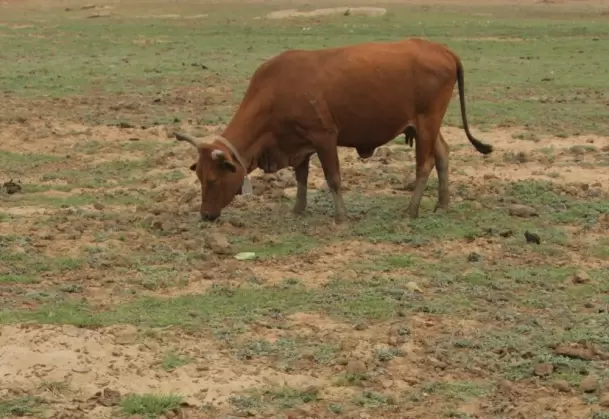11 out of 36 Maharashtra districts 'highly vulnerable' to climate change
New Delhi
06-August-2021

Photo:IANS
Eleven out of the 36 districts in Maharashtra have been found to be 'highly vulnerable' to extreme weather events, droughts and dwindling water security and account for almost 40 per cent of the cropped area across central Maharashtra, a latest study has found.
However, the study did not include Mumbai and suburban districts in the analysis.
The farmers from western Maharashtra and Konkan are already battling the worst floods in recent times. The study adds that extreme climate conditions are affecting the livelihoods and the agrarian economy of Maharashtra may get worse from here on.
The study was conducted by Chaitanya Adhav from the Indian Council of Agricultural Research (ICAR)-National Dairy Research Institute (NDRI), Karnal, Haryana, under the guidance of R. Sendhil from ICAR-Indian Institute of Wheat and Barley Research.
Nandurbar in north Maharashtra is the most vulnerable district to cyclones, floods, droughts, changing rainfall patterns and extreme temperatures, affecting its crop production.
The other 10 highly vulnerable districts include Buldhana, Beed, Jalna, Aurangabad, Hingoli, Parbhani, Nanded, Akola, Amravati and Washim.
Watch This TWL Video
The 14 moderately vulnerable districts include Dhule, Jalgaon, Ratnagiri, Sindhudurg, Sangli, Solapur, Osmanabad, Latur, Yavatmal, Wardha, Chandrapur, Bhandara, Gondia and Gadchiroli.
According to India's Livelihoods Report 2019, farming is the prime livelihood source for 51 per cent of Maharashtra's population.
Adhav said the findings showed that most of the highly vulnerable districts fell under the Central Maharashtra Plateau Zone, which constitutes 22.22 per cent share of the total cropped area in Maharashtra. The Central Vidarbha Zone has an additional share of 6.78 per cent area as highly vulnerable.
The authors explained that to quantify the climate change induced risk, the socio-economic vulnerability index (SEVI) was calculated using the Intergovernmental Panel on Climate Change (IPCC) approach, considering the key climatic parameters such as exposure, sensitivity and adaptive capacity of districts to climate vulnerability.
The data was collected on 44 indicators related to climatic as well as socio-economic variables, which were identified based on experts' opinion.
"Mapping of the districts shows that there is an instant need for focused policy efforts to address the socio-economic vulnerability in the Central Maharashtra Plateau Zone, Scarcity Zone (Dhule, parts of Nandurbar and Aurangabad), and the Eastern Vidarbha Zone," Adhav said.
Nine districts -- Palghar, Thane, Raigad, Nashik, Satara, Kolhapur, Ahmednagar, Nagpur and Pune -- were found to be least vulnerable to climate agricultural distress, the release said.
The dominant crops from these districts which will bear the brunt of climate change in future include jowar, rice, wheat, sugarcane, cotton, ragi, cashew nut, barley and millets, the scientists added, even as they pointed out how there is a lot of discussion about the impacts of climate change on agriculture, but very little action is being taken on the ground.
Pointing out that changing crop patterns is a solution that is not going to be an easy task, agriculture expert and a trustee of the Marathwada Sheti Sahayak Mandal (MSSM), a citizen's movement, Vijay Anna Borade, said, "We need to create parallel programmes with adequate drainage, drip irrigation, crop rotation etc. to get stability in crop productivity and stable income for farmers. Only then can we divert farmers to change their crop pattern. Another option is controlled farming, which also has financial limitations."
During the last decade, there were severe droughts in 2014, 2015, 2016 and 2018, massive hailstorms in 2014 and 2015, and excess rainfall and flooding in 2016, 2019 and 2021.
For the Konkan areas, the situation has aggravated with impacts due to back-to-back cyclones Nisarga and Tauktae in 2020 and 2021, respectively.
Akshay Deoras, an independent meteorologist and a PhD student at the University of Reading in England, said, "Lack of a robust weather-forecast dissemination system adds to the vulnerability. The weather and crop advisories are sent through various channels, but such services need to improve so as to make a significant positive impact on farmers."-IANS
More Headlines
Mumbai Police Bust High-Profile Sex Racket in Hiranandani Hotel
NPG Evaluates 8 Key Infrastructure Projects Under PM GatiShakti Plan
Rupee Symbol Debate Heats Up as Tamil Nadu Opts for ‘ரூ’
AIADMK Walks Out, BJP Boycotts Tamil Nadu Budget Session
AI Cybersecurity Startup Neural Defend Raises $600K in Pre-Seed Round
Mumbai Police Bust High-Profile Sex Racket in Hiranandani Hotel
NPG Evaluates 8 Key Infrastructure Projects Under PM GatiShakti Plan
Rupee Symbol Debate Heats Up as Tamil Nadu Opts for ‘ரூ’
AIADMK Walks Out, BJP Boycotts Tamil Nadu Budget Session
AI Cybersecurity Startup Neural Defend Raises $600K in Pre-Seed Round










